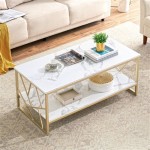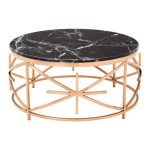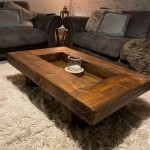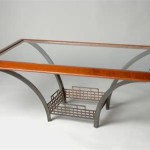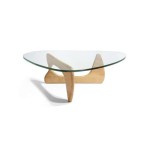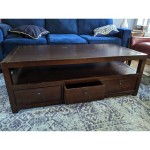Mid-Century Coffee Table Bases: A Guide to Design, Materials, and Selection
The mid-century modern aesthetic, characterized by clean lines, organic shapes, and a focus on functionality, continues to be a prominent design influence in contemporary interiors. A crucial element within this style is the coffee table, and particularly its base. The coffee table base not only provides structural support but also significantly contributes to the overall aesthetic of the piece and the surrounding space. Understanding the nuances of mid-century coffee table bases necessitates an examination of their design principles, common materials, and the key considerations for selecting the appropriate base for a specific application.
Key Design Principles of Mid-Century Coffee Table Bases
Mid-century modern design philosophy emphasizes simplicity and elegance. This is clearly reflected in the design of coffee table bases from this era. A departure from the ornate detailing of previous styles, mid-century bases prioritize clean, uncluttered forms. This often translates to geometric shapes, tapered legs, and a general absence of excessive embellishment.
Another defining characteristic is the incorporation of organic forms. While geometric shapes are prevalent, they are often softened by curves and subtle angles that mimic natural forms. This balance between geometry and organicism is a hallmark of the mid-century modern aesthetic. Examples include splayed legs that resemble tree branches or rounded edges that soften the overall appearance of the base.
Functionality plays a central role. The design of the base isn't merely aesthetic; it's directly tied to the table's utility. Stability and balance are paramount, and the base is engineered to provide optimal support for the tabletop, regardless of its material or size. This emphasis on practicality ensures that the coffee table is not only visually appealing but also functional and durable.
Furthermore, mid-century designs frequently showcase the materials used. Rather than concealing the construction, designers often highlighted the natural beauty of the wood grain or the sleekness of metal. Joinery techniques, such as exposed dovetails or mortise and tenon joints, were sometimes incorporated as decorative elements, adding visual interest and demonstrating the craftsmanship involved.
Common Materials Used in Mid-Century Coffee Table Bases
The selection of materials is crucial in defining the character of a mid-century coffee table base. Several materials were commonly employed, each contributing unique characteristics to the overall design.
Wood is perhaps the most prevalent material. Teak, walnut, and birch were particularly popular due to their rich color, attractive grain patterns, and inherent durability. These hardwoods were often used in solid form for legs and stretchers, showcasing the natural beauty of the wood. The warm tones and natural textures of wood contribute to the overall organic feel of mid-century modern furniture.
Metal, particularly steel and wrought iron, also played a significant role. Metal bases offered a contrasting aesthetic to wood, providing a sleek, industrial edge. Steel was often used for slender, minimalist legs, while wrought iron allowed for more intricate and decorative designs. Metal bases were sometimes painted in neutral colors, such as black or white, or left with a natural finish to showcase the material's inherent qualities. Brass accents were also popular, adding a touch of glamour and sophistication.
Less common, but still notable, are the use of materials like fiberglass and laminate. These synthetic materials allowed for greater design flexibility and experimentation with color and texture. Fiberglass could be molded into complex shapes, while laminate offered a durable and easy-to-clean surface. These materials represent the mid-century modern movement's embrace of innovation and new technologies.
The combination of materials was also a common practice. For example, a wooden tabletop might be paired with a metal base, creating a visual contrast and highlighting the unique qualities of each material. This interplay of materials adds depth and complexity to the design, showcasing the designer's skill in creating a harmonious and balanced aesthetic.
Considerations for Selecting a Mid-Century Coffee Table Base
Choosing the right mid-century coffee table base involves several important considerations. These factors ensure that the base is not only aesthetically pleasing but also functional and appropriate for the intended use and environment.
The size and shape of the tabletop are paramount. The base must be adequately sized to support the tabletop without compromising stability. A small base under a large tabletop could lead to instability and potential damage. The shape of the tabletop should also be considered. A round tabletop, for example, typically requires a different base configuration than a rectangular one. The base should complement the tabletop shape and provide balanced support.
The overall style of the room is another crucial factor. The coffee table base should integrate seamlessly with the existing décor. If the room features predominantly wooden furniture, a wooden base would likely be the most appropriate choice. Conversely, if the room has a more industrial or minimalist aesthetic, a metal base might be a better fit. Consider the colors, textures, and overall design themes of the room when selecting a base.
The intended use of the coffee table should also be considered. If the table is primarily for decorative purposes, a more delicate or sculptural base might be suitable. However, if the table will be used for everyday activities, such as holding drinks and snacks, a more robust and stable base is necessary. Consider the level of wear and tear the table will be subjected to and choose a base that can withstand it.
Finally, budget is always a factor. Mid-century coffee table bases can range in price from relatively inexpensive to quite expensive, depending on the materials, craftsmanship, and designer. Setting a budget beforehand can help narrow down the options and ensure that the chosen base is both aesthetically pleasing and financially feasible. Consider exploring vintage options or reproductions to find a base that fits within your budget without compromising on quality or style.
The details of the joinery used in the coffee table base are also important to consider. High-quality joinery, such as dovetail joints or mortise and tenon joints, indicates a well-crafted piece that is built to last. Weak or poorly executed joinery can lead to instability and premature failure of the base. Inspect the joinery carefully to ensure that it is strong and secure.
Furthermore, the finish of the base should be carefully considered. A well-applied finish protects the material from damage and enhances its aesthetic appeal. For wooden bases, consider the type of finish, such as oil, lacquer, or varnish, and how it complements the wood's natural grain. For metal bases, consider the type of coating, such as powder coating or plating, and how it will resist scratches and corrosion. Choose a finish that is both durable and visually appealing.
Ultimately, selecting a mid-century coffee table base is a process that requires careful consideration of various factors. By understanding the design principles, materials, and key considerations, individuals can choose a base that perfectly complements their tabletop and enhances the overall aesthetic of their living space. The right coffee table base can be a statement piece that adds character and sophistication to any room.

Mid Century Modern Coffee Table

Building A Midcentury Modern Coffee Table Shaun Boyd Made This
How To Build A Diy Mid Century Modern Coffee Table Tablelegs

Mid Century Modern Coffee Table

Midcentury Modern Coffee Table Solid Wood And Copper

How To Build A Mid Century Modern Coffee Table With 3 Legs Woodworking

Acute Prism Handcrafted Mid Century Modern Design Coffee Table Wood Base Noguchi Replacement Oval Rectangular

Gzxs Modern Mid Century Wood Coffee Table With Metal Legs 47 24 Rectangle Center For Living Room Bedroom Apartment Brown Com

Midcentury Modern Coffee Table Solid Wood And Copper

Mid Century Round Coffee Table 36 West Elm
